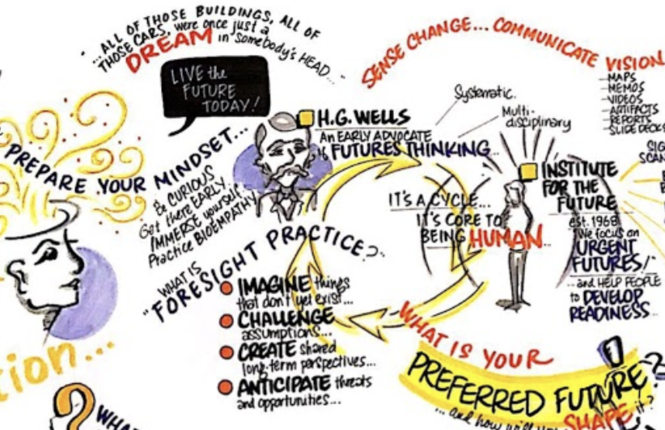Future Now
The IFTF Blog
The IFTF Foresight Training Experience: A First-Timer’s View
I’ve been practicing strategic foresight for nearly a year now. I joined IFTF in early 2018, supporting Distinguished Fellow Bob Johansen. Bob taught me nearly everything there is to know about Futures Thinking, but one of the very few drawbacks of working with such a brilliant mind is trying to absorb all there is to know at once. At times, watching foresight unfold and even taking a crack at creating my own forecasts felt like trying to drink water from a firehose.
When I joined the Foresight Training in late February of this year, I realized that many in my cohort felt the same way. As we ate breakfast and introduced ourselves to one another informally on Day One, there was a sense of excitement and some small sentiment of caution – the future is scary, and no one can predict it accurately, so how can I get practical tools to start using? Will these tools be too complex to do on my own? Are the current tools and frameworks I use today strikingly different from what the IFTF Foresight Toolkit has to offer? How does Futures Thinking fit into my line of work?

Our first day was organized primarily around the Prepare section of the Prepare-Foresight-Insight-Action cycle. The link to neuroscience and how our brains envision the future (and even ourselves in the future) was a concept very few in the room had known or considered. Signals of change were difficult to grasp for many participants, too. I offered up my own signal – a college café that gives students coffee and pastries they pay for not with money or even cryptocurrency - but with personal data. The room collectively gasped and small conversations began at the individual tables. “If a signal can make you gasp, pulls you back, and makes you think ‘Oh wow! That’s different,’ then chances are you’ve found a good signal,” I said.
The tools in the Foresight section of toolkit were intuitive and practical for participants. “Draft a Forecast” was difficult at first, but became rather intuitive for participants. “Reveal Unexpected Possibilities,” “Draw Out Consequences”, and “Envision Alternative Futures” were incredibly popular tools that got the group excited about engaging in uncertain futures. “I like these tools because my team feels too operational. I challenge them to move towards becoming strategic thinkers and they get stuck. These tools give them a practical framework for making that shift,” someone commented.

The most surprising insight to me came from a participant with a distributed team. Their challenge was how to cascade Foresight and Futures Thinking to distributed and very siloed educators. Suggestions at the table included: live survey polls for “Orient to the Future,” Google Docs for “Map Cross-Impacts.” But her challenge got me thinking.
As Futurists looking ten years out into the future, we forecast large-scale drivers of change that are moving from being on the horizon towards become fully adopted and integrated in our everyday lives. We have forecasted the rise of both distributed and decentralized networks, authorities, and workforces: but do our tools and methodologies adequately address that? For example, if we can confidently say that embedded sensors are becoming cheaper and more invasive and will be able to track nearly every inch of our bodies and environments, how might this same tech aid us in Futures Thinking? What about a sensor that shows changes in mood and temperament when we are confronted with exploring an unknown future? Or an algorithm that takes a forecast and plots potential consequences, prioritizes actions and reactions, or builds a virtual network for us to rely on?
Futures Thinking is a challenge, but applying a futures approach to the practice of learning and teaching Futures Thinking is an entirely different concept. As IFTF helps organizations operationalize embedded Futures Thinking, it will be this growth opportunity that uses new resources to streamline this time-tested process of Foresight-Insight-Action.



